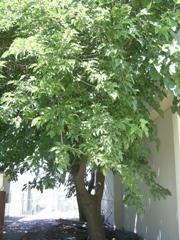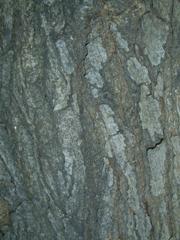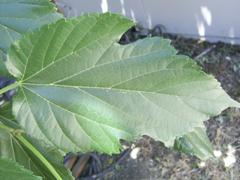Fruitless Mulberry
Morus albaFamily: Moraceae
Podcast Script
 whole tree |
 bark |
 leaf |
 flower Image source |
Classification:
-Angiosperm, Dicot, deciduousSize:
-Can grow up to 30-50 ft.Identifying Features:
-Deciduous (shed their leaves annually)-Stems contain a milky sap that has latex in it.
-Branches are gray to yellow-gray and young branches have an orange tinge to them.
-Bark is rough
-Heart-shaped leaves, which are a primary source of food for silkworms.
-Fast-growing
-Provides excellent shade with its big leaves.
-Leaves are large, bright green, glossy and are deeply veined.
Location/Habitat:
-Native to China, Japan, Thailand, Malaysia, and Birma.-A native of China, escapes have become naturalized in North America and Europe.
-It prefers deep soil but can tolerate a variety of conditions.
Flower/Fruit/Reproduction:
-Individual male flowers contain four stamens, each with an anther and filament. At the bottom of each filament, there's a fleshy, green sepal.Water/Sun Requirements:
-Low, flexible on water uptake.Special Adaptations:
-Can grow in alkaline soil and during a drought.Other Info:
-Pollution resistant, so it's good for urban areas.-Resilient to pests and diseases
-Also known as the "White Mulberry".
-The Fruitless Mulberry was probably the parent of the original American 'Downing' Mulberry, which was selected for its fruit yield.
-This tree used to be considered one of the two most important timber trees of China, and most Chinese homesteads had one or two of each planted nearby. They were also very important for the production of silk. The expression "Sang Tzu" means "Land of the mulberry and catalpa" and it's still a common phrase in Chinese meaning in "home" or "homeland".
-This species of Mulberry is fruitless and therefore does not make a mess when planted in urban areas. This in addition to its ability to survive drought make it one of the easiest plants to care for because it does not need much. The tree is dense and broad and therefore gives a lot of shade. Although the fruitless mulberry does not create messy fruits it does shed leaves during the fall. The buds of the mulberry also can create messes.
Reference Sources/Links:
How Stuff WorksBotany 115 Terminology
Multiple Fruits of the Mulberry Family
Morus alba fruitless cultivars White Mulberry
Davis Wiki
Created by Heather B. 2007